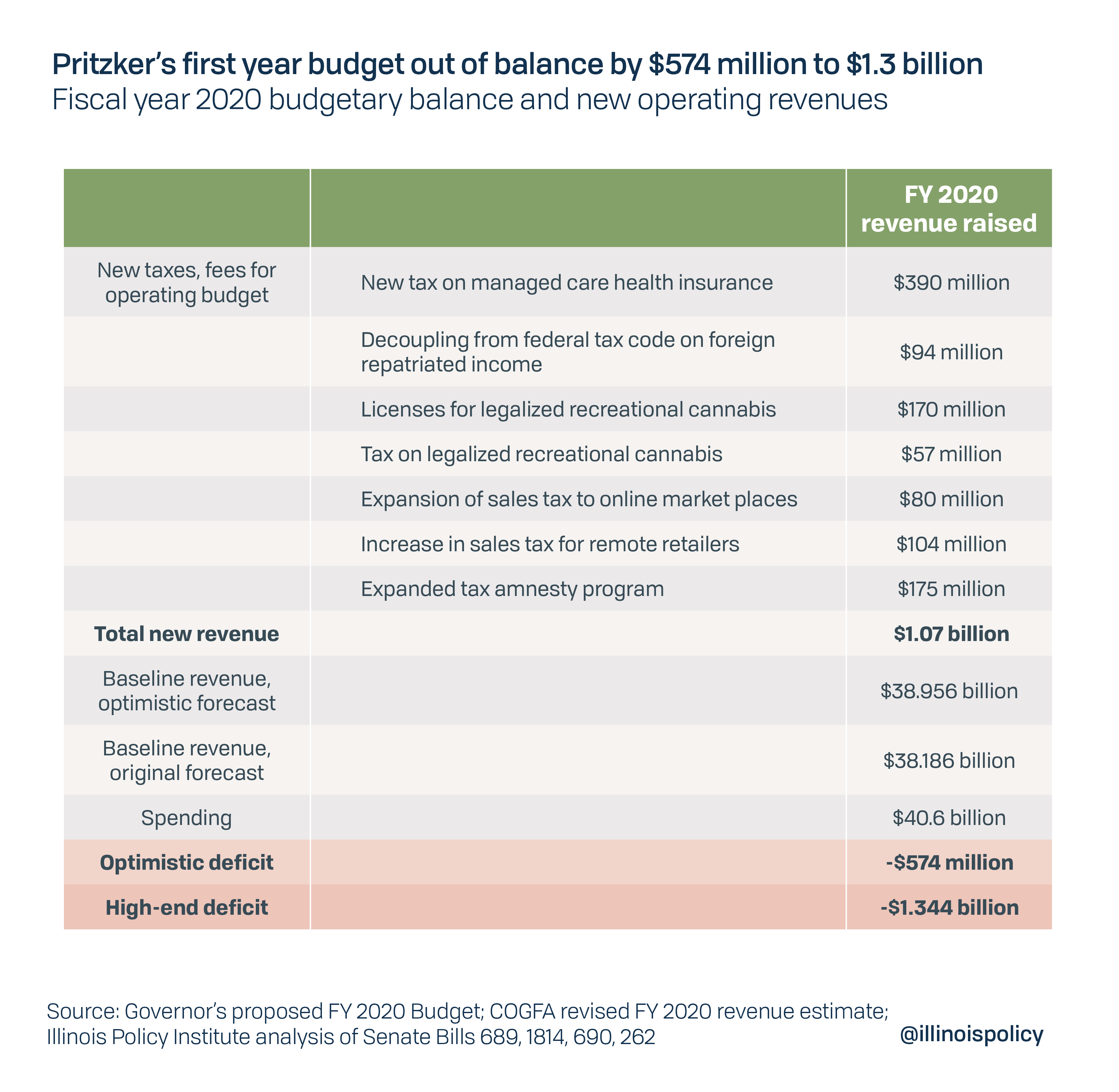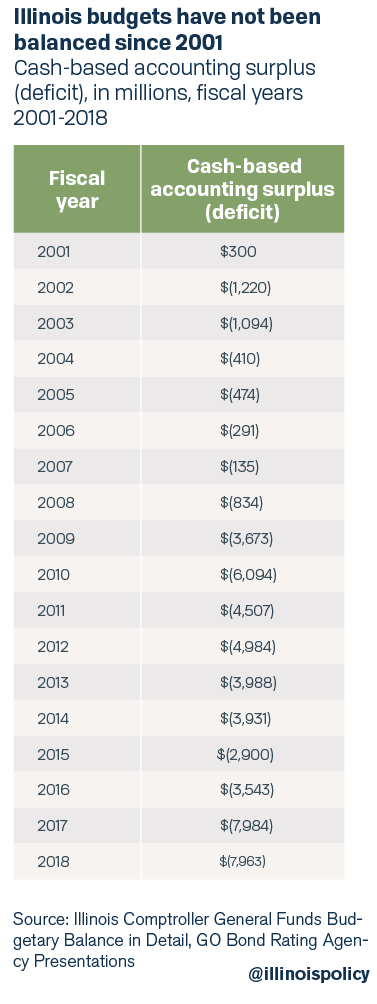Pritzker signs Illinois budget out of balance by up to $1.3 billion
Contrary to claims from both Republicans and Democrats, and despite raising nearly $1.1 billion in new taxes and fees for operations, the fiscal year 2020 budget is out of balance by between $574 million and $1.3 billion.
Illinois Gov. J.B. Pritzker on June 6 signed a 2020 state budget that will cost $40.6 billion in general revenues, as much as $1.3 billion more than the state will bring in for the fiscal year that starts July 1.
The Illinois House and Senate passed the budget, Senate Bill 262, on bipartisan votes of 83-35 and 40-19. Despite public claims from both Republicans and Democrats, the 1,581-page spending plan is out of balance by between $574 million and $1.3 billion, depending on the optimism used in the revenue estimate.
 These deficits exist even after including nearly $1.1 billion in new revenue through Pritzker’s tax and fee increases that will be deposited into general revenues. Those represent seven of the 20 tax and fee hikes enacted by the General Assembly this year. The remaining tax and fee hikes are dedicated to the state’s new 6-year, $45-billion infrastructure plan, which includes spending on roads, bridges, state facilities and more.
These deficits exist even after including nearly $1.1 billion in new revenue through Pritzker’s tax and fee increases that will be deposited into general revenues. Those represent seven of the 20 tax and fee hikes enacted by the General Assembly this year. The remaining tax and fee hikes are dedicated to the state’s new 6-year, $45-billion infrastructure plan, which includes spending on roads, bridges, state facilities and more.
Lawmakers said they aren’t counting on the potential $57 million in revenue from the first year of legal recreational marijuana sales, but that money was included in the deficit projection to be as generous as possible to those claiming the budget is balanced.
The Commission on Government Forecasting and Accountability, or COGFA, in March estimated fiscal year 2020 revenues at $38.186 billion, but revised that number up to $38.956 billion after the “April surprise” of $1.5 billion in higher than expected revenues, mostly resulting from federal tax reform and faster than expected national economic growth. After the Illinois Department of Revenue announced it was raising its revenue estimate, Illinois’ Democratic Comptroller Susana Mendoza said she could neither “confirm nor deny” the higher estimate. She urged caution.
An estimate last November by the Governor’s Office of Management and Budget, or GOMB, projected total revenues would be just $37.873 billion. It was the last estimate under Republican Gov. Bruce Rauner and accounted for the possibility of a mild recession lasting three quarters. If that projection proves accurate and a recession strikes, the budget deficit would grow to more than $1.6 billion. Recent surveys have found 75% of business economists in the U.S. expect the next recession to hit by 2021.
A status quo budget for a state with 19 years of consecutive deficits
The Illinois Constitution technically requires a balanced budget, but the requirement is toothless. The constitution reads: “The General Assembly by law shall make appropriations for all expenditures of public funds by the State. Appropriations for a fiscal year shall not exceed funds estimated by the General Assembly to be available during that year.”
The word “estimated” is key to understanding why it is ineffective. The requirement applies to the budget planning stage, and does not require the budget to actually balance at the end of the year. This allows for numerous budget gimmicks, including overestimating revenue and underestimating expenditures.
Illinois is one of just 11 states that permits a deficit to be carried from one year to the next, according to the National Association of State Budget Officers.
As a result, politicians claim the budget is balanced nearly every year. But Illinois has spent more money than it brought in every year since 2001.

State leaders played the same fiscal games last year, claiming they passed a balanced budget when a close analysis by the Illinois Policy Institute showed it was up to $1.5 billion shy of what was needed. A few months later the truth came out when the state wanted to borrow from bond buyers and admitted the budget was $1.2 billion in the red.
Hidden costs and spending increases
Among spending increases included in the new budget are:
- $410 million in backpay for unionized state workers to offset a pay freeze imposed by former Gov. Rauner and $185 million in automatic raises for the coming year.
- $375 million more for the state’s new “evidence-based” school funding formula, which requires annual increases of at least $350 million.
- $134 million for public universities, including a $50-million increase for grants to low-income students through the Monetary Award Program.
- $130 million more for the Department of Children and Family Services.
- $50 million extra for the Early Childhood Block Grant.
Pritzker campaigned on many of these spending increases, so they come as no surprise. But there are also hidden costs in the budget bill that were not widely discussed in the General Assembly before it passed. These include:
- Pay raises for state lawmakers of $1,600 each
- An increase of $19,000 per year on lawmakers’ in-district allowance, bringing their total to $88,000 per year
- Lifting caps on pension spiking by school districts that will cost taxpayers about $22 million per year
Given that lawmakers had only 12 hours to read the 1,581-page budget bill, some might have missed the fine points before voting on it.
Still flying blind
The General Assembly never adopted a formal revenue estimate, meaning they decided how much money to spend without formally agreeing on how much they had in the first place. Both statutory law and the Illinois Constitution appear to require the formal adoption of a revenue estimate by the General Assembly.
The statute, which applies to COGFA, states: “The House and Senate by joint resolution shall adopt or modify such estimates as may be appropriate. The joint resolution shall constitute the General Assembly’s estimate, under paragraph (b) of Section 2 of Article VIII of the Constitution, of the funds estimated to be available during the next fiscal year.”
COGFA is one of two entities required to produce revenue estimates. The executive estimate comes from the GOMB and is used by the governor in his annual budget proposal.
From 2008 to 2017, COGFA revenue estimates were “on target” in only four of 10 years and GOMB estimates were on target only twice. The National Association of State Budget Officers considers estimates to be “on target” if within 0.5% of actual revenues.
Agreeing on a revenue estimate is an important best practice in state budget making, but the state has not done so since at least 2014. Ideally, estimates from the legislative branch and executive branch should be averaged to minimize potential biases and therefore increase accuracy. Expert research has consistently found evidence of motivated math in government revenue projection. Even non-political staff often feel pressured to make numbers match the political objectives of their elected bosses.
Breaking the cycle of tax hikes, unbalanced budgets
Pritzker has repeatedly presented a false choice to Illinoisans as he pushes to amend the Illinois Constitution to replace the state’s flat tax with a graduated, or progressive, income tax. The Illinois Policy Institute has produced research showing the progressive tax would harm the state’s economy and eventually lead to middle-class tax hikes, rather than fixing the state’s fiscal problems as the governor claims. Those were the results after Connecticut became the only state in 30 years to impose a progressive income tax.
Pritzker said the only alternative is severe cuts to core government services. He even claimed opponents of his graduated income tax don’t have a plan to fix Illinois’ finances in the long term. Both are wrong.
Through structural spending reform to the cost drivers of spending growth, the Illinois Policy Institute’s Budget Solutions 2020 five-year fiscal plan would immediately balance the budget and use annual surpluses to eliminate the state’s long-running bill backlog – a form of short-term debt that carries high interest penalties. Once the bill backlog is eliminated, savings from the reforms could be used to build up the state’s paltry rainy day fund and deliver relief to taxpayers.
The Institute’s plan would have spent nearly $2.8 billion less than the Pritzker plan, while ensuring core government services were funded. This would have created a more than $1-billion surplus compared to COGFA’s optimistic revenue estimate, and a surplus of $246 million compared to the original revenue estimate.
Contrary to the governor’s claims, balancing budgets and paying off debt can be accomplished without cuts to services that provide value to Illinois’ taxpayers. They can be done without adopting an economically harmful progressive income tax.